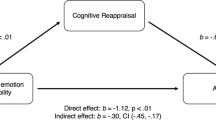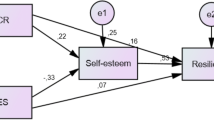Abstract
Habitual emotional state is a predictor of long-term health and life expectancy and successful emotion regulation is necessary for adaptive functioning. However, people are often unsuccessful in regulating their emotions. We investigated the use of cognitive reappraisal and expressive suppression in 489 university students in Norway, Australia, and the United States and how these strategies related to measures of well-being (affect, life satisfaction, and depressed mood). Data was collected by means of selfadministered questionnaires. The major aims of the study were to begin to explore the prevalence of use of cognitive reappraisal and expressive suppression across gender, age and culture, possible antecedents of emotion regulation strategies, and the influence of emotion regulation upon well-being. Results showed that the use of emotion regulation strategies varied across age, gender and culture. Private self-consciousness (self-reflection and insight) was found to be a central antecedent for the use of cognitive reappraisal. Use of emotion regulation strategies predicted well-being outcomes, also after the effect of extraversion and neuroticism had been controlled for. Generally, increased use of cognitive reappraisal predicted increased levels of positive well-being outcomes, while increased use of expressive suppression predicted increased levels of negative well-being outcomes.
Similar content being viewed by others
Notes
The law of Jante (Janteloven) represents a cultural norm or “law” that has traditionally ruled the Scandinavian, and particularly the Norwegian, mentality (Jespersen 1962).
The terms private self-consciousness and self-reflection and insight are used interchangeably in the present paper. That is, when the term private self-consciousness is used it refers to both self-reflection and insight.
As the present study comprised a student population, the average age was fairly low and the cut-point age used for analytic purposes was therefore quite young.
Gabriel’s comparison procedure was used as the sample sizes differed slightly between cultures, and because it has been designed to cope specifically with such situations (Field 2005, p. 276).
These correlations and regressions were also executed controlling for gender, and as gender was found to not confound the findings pertaining to strategies and well-being, it is not discussed herein.
We also ran the same regressions with extraversion and neuroticism included as predictors, but the betas did not change substantially.
References
Bower, G. H. (1981). Mood and memory. American Psychologist, 36, 1129–1148.
Brooks, G. R. (1998). A new psychotherapy for traditional men. San Francisco: Jossey-Bass Publishers.
Butler, E. A., Egloff, B., Wilhelm, F. W., Smith, N. C., Erickson, E. A., & Gross, J. J. (2003). The social consequences of expressive suppression. Emotion, 3, 48–67.
Campos, J. J., Frankel, C. B., & Camras, L. (2004). On the nature of emotion regulation. Child Development, 75(2), 377–394.
Chioqueta, A. P., & Stiles, T. C. (2005). Personality traits and the development of depression, hopelessness, and suicide ideation. Personality and Individual Differences, 38(6), 1283–1291.
DeNeve, K. (1999). Happy as an extraverted clam? The role of personality for subjective well-being. Current Directions in Psychological Science, 8(5), 141–144.
Diener, E., Emmons, R. J., & Griffin, S. (1985). The satisfaction with life scale. Journal of Personality Assessment, 49, 71–76.
Ekman, P. (1992). An argument for basic emotions. Cognition and Emotion, 6, 169–200.
Ekman, P. (1972). Universals and cultural differences in facial expressions of emotion. 1971. In J. R. Cole (Ed.), Nebraska symposium on motivation, 19 (pp. 207–283). Lincoln: University of Nebraska Press.
Field, A. (2005) Discovering statistics using SPSS for windows (2nd ed.). Thousand Oaks: Sage Publications.
Feldman Barrett, L., Gross, J. J., Conner, T., & Benvenuto, M. (2001). Knowing what you’re feeling and knowing what to do about it: Mapping the relation between emotion differentiation and emotion regulation. Cognition and Emotion, 15, 713–724.
Forgas, J. P., & Bower, G. H. (1987). Mood effects on personal perception judgments. Journal of Personality and Social Psychology, 51, 140–148.
Grant, A. M., Franklin, J., & Langford, P. (2002). The self-regulation and insight scale: A new measure of private self-consciousness. Social Behavior and Personality, 30(8), 821–836.
Gratz, K. L., & Roemer, L. (2004). Multidimensional assessment of emotion regulation and dysregulation: Development, factor structure, and initial validation of the difficulties in emotion regulation scale. Journal of Psychopathology and Behavioral Assessment, 26, 41–54.
Gross, J. J. (1998a). Antecedent- and response-focused emotion regulation: Divergent consequences for experience, expression, and physiology. Journal of Personality and Social Psychology, 74, 224–237.
Gross, J. J. (1998b). The emerging field of emotion regulation: An integrative review. Review of General Psychology, 2, 271–299.
Gross, J. J. (1999). Emotion and emotion regulation. In L. A. Pervin & O. P. John (Eds.), Handbook of personality: Theory and research (2nd ed., pp. 525–552). New York: Guilford Press.
Gross, J. J. (2002). Emotion regulation: Affective, cognitive, and social consequences. Psychophysiology, 39, 281–291.
Gross, J. J., & John, O. P. (2003). Individual differences in two emotion regulation processes: Implications for affect, relationships, and well-being. Journal of Personality and Social Psychology, 85, 348–362.
Gross, J. J., & Levenson, R. W. (1993). Emotional suppression: Physiology, self-report, and expressive behaviour. Journal of Personality and Social Psychology, 64, 970–986.
Gross, J. J., Richards, J. M., & John, O. P. (2006). Emotion regulation in everyday life. In D. K. Snyder, J. A. Simpson, & J. N. Hughes (Eds.), Emotion regulation in families: Pathways to dysfunction and health (pp. 13–35). Washington, DC: American Psychological Association.
Helman, C. G. (2002). Culture, health, and illness (4th ed.). London: Arnold.
Himmelfarb, S., & Murrell, S. A. (1983). Reliability and validity of five mental health scales in older persons. Journal of Gerontology, 38(3), 333.
Hofstede, G. (1991). Culture and organizations: Software of the minds. London: McGrawHill.
Jespersen, B. F. (1962). www.bearcy.com/janteloven.html
John, O. P., & Gross, J. J. (2004). Healthy and unhealthy emotion regulation: Personality processes, individual differences, and life span development. Journal of Personality, 72, 6, 1301–1333.
John, O. P., & Srivastava, S. (1999). The Big Five trait taxonomy: History, measurement, and theoretical perspectives. In L. A. Pervin & O. P. John (Eds.), Handbook of personality: Theory and research (2nd ed., pp. 102–138). New York: Guilford Press.
Keltner, D., & Haidt, J. (2001). Social function of emotions. In T. Mayne & G. A. Bonanno (Eds.), Emotions: Current issues and future directions (pp. 192–213). New York: Guilford Press.
Larsen, R. J., & Prizmic, Z. (2004). Affect regulation. In R. F. Baumeister & K. D. Vohs, (Eds.), Handbook of self-regulation. research, theory, and application. New York: Guilford Press.
Lazarus, R. S. (1991). Emotion and adaptation. New York: Oxford University Press.
Levenson, R. W. (1994). Human emotions: A functional view. In P. Ekman & R. J. Davidson (Eds.), The nature of emotion: Fundamental questions (pp. 123–126). New York: Oxford University Press.
Mennin, D. S., Heimberg, R. G., Turk, C. L., & Fresco, D. M. (2002). Applying an emotion regulation framework to integrative approaches to generalized anxiety disorder. Clinical Psychology: Science and Practice, 9, 85–90.
Miles, H. J., & Gross, J. J. (1999). Emotion suppression. In D. Levinson, J. Ponzetti, & P. F. Jorgensen (Eds.), Encyclopaedia of human emotions (pp. 237–241). New York: Macmillan.
Monsen, J. T., & Monsen, K. (1999). Affekter og affektbevisshet: Et bidrag til integrerende psykoterapimodell. In Goldberg, A. (Ed.), Pluralisms in self-psychology: Progress in self-psychology, (Vol. 15, pp. 287–306). New Jersey: The analytic press.
Nussbaum, M. C. (2001). Upheavals of thought: The intelligence of emotions. Cambridge: Cambridge University Press.
Pavot, W., & Diener, E. (1993). Review of the satisfaction with life scale. Psychological Assessment, 5, 164–172.
Preacher, K. J., & Hayes, A. F. (2004). SPSS and SAS procedures for estimating indirect effects in simple mediation models. Behavior Research Methods, Instruments, & Computers, 36(4), 717–731.
Radloff, L. S. (1991). The use of the center for epidemiologic studies depression scale in adolescents and young adults. Journal of Youth & Adolescence, 20(2), 149–166.
Radloff, L. S. (1977). The CES-D scale: A self-report depression scale for research in the general population. Applied Psychological Measurement, 1, 385–401.
Richards, J. M., & Gross, J. J. (2000). Emotion regulation and memory: The cognitive costs of keeping one’s cool. Journal of Personality and Social Psychology, 79, 410–424.
Richards, J. M., & Gross, J. J. (1999). Composure at any cost? The cognitive consequences of emotion suppression. Personality and Social Psychology Bulletin, 25, 1033–1044.
Roberts, R. E., & Vernon, S. W. (1983). The center for epidemiologic studies depression scale: Its use in a community sample. American Journal of Psychiatry, 140(1), 41.
Rottenberg, J., & Gross, J. J. (2003). When emotion goes wrong: Realizing the promise of affective science. Clinical Psychology: Science and Practice, 10(2), 227–232.
Salovey, P., Mayer, J. D., Goldman, S. L., Turvey, C., & Palfai, T. P. (1995). Emotional attention, clarity, and repair: Exploring emotional intelligence using the trait meta-mood scale. In J. W. Pennebaker (Ed.), Emotion, disclosure, and health (pp. 125–154). Washington: American Psychological Association.
Salovey, P., Hsee, C. K., & Mayer, J. D. (1993). Emotional intelligence and the self-regulation of affect. In D. M. Wegner & J. W. Pennebaker (Eds.), Handbook of mental control (pp. 258–277). Englewood Cliffs: Prentice Hall.
Santor, D.A., & Coyne, J. C. (1997). Shortening the CES-D to improve its ability to detect cases of depression. Psychological Assessment, 9(3), 233.
Schimmack, U., Oishi, S., Furr, R. M., & Funder, D. C. (2004). Personality and life satisfaction: A facet-level analysis. Personality and Social Psychology Bulletin, 30(8), 1062–1075.
Schweder, R. (1993). The cultural psychology of the emotions. In M. Lewis & J. M. Haviland (Eds.), Handbook of emotions (pp. 417–431). New York: Guilford Publications.
Tsai, J. L., & Levenson, R. W. (1997). Cultural influences of emotional responding: Chinese American and European American dating couples during interpersonal conflict. Journal of Cross-Cultural Psychology, 28(5), 600–625.
Vygotsky, L. S. (1978). Mind in society: The development of higher psychological processes. Cambridge: Harvard University Press.
Watson, D., Clark, L. A., & Tellegen, A. (1988). Development and validation of brief measures of positive and negative affect: The PANAS scales. Journal of Personality and Social Psychology, 54, 1063–1070.
Author information
Authors and Affiliations
Corresponding author
Rights and permissions
About this article
Cite this article
Haga, S.M., Kraft, P. & Corby, EK. Emotion Regulation: Antecedents and Well-Being Outcomes of Cognitive Reappraisal and Expressive Suppression in Cross-Cultural Samples. J Happiness Stud 10, 271–291 (2009). https://doi.org/10.1007/s10902-007-9080-3
Received:
Accepted:
Published:
Issue Date:
DOI: https://doi.org/10.1007/s10902-007-9080-3




